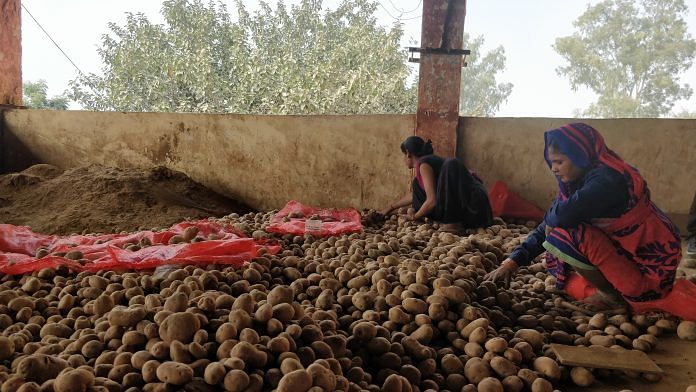Like milk, government wants to develop a market for onions, potatoes and tomatoes, launches new scheme with a corpus of Rs 500 crore to help farmers.
New Delhi: Finance minister Arun Jaitley, in his budget speech Thursday, announced that the government proposes to launch ‘Operation Green’ to develop the market for onions, potatoes and tomatoes, along the lines of ‘Operation Flood’ for milk. Operation Green has been allocated a corpus of Rs 500 crore.
Launched in 1970, Operation Flood, also known as the white revolution, had the twin objectives of increasing milk production and empowering farmers. At the time, India was milk deficient, importing to meet its growing needs. Thirty-six years later, in 2016, India ranked first in milk production, accounting for 18.5 per cent of world production.
ThePrint looks at key elements of Operation Flood, and how it can shape agriculture through the new initiative.
Interlinkage and cooperatives
Operation Flood was aimed at forming a national milk grid that connected milk producers in rural areas to consumers in urban areas. Delhi, Mumbai, Kolkata and Chennai were the cities initially targeted to create a market. The grid was to be developed by removing middlemen and consolidating milk producers through cooperatives.
The grid helped in multiple ways. Effectively reaching consumers without middlemen enabled higher monetary incentives for producers. The demand-supply gaps closed as well, as milk pricing was less susceptible to regional and seasonal variation.
Operation Flood also brought with it the benefits of cooperatives. It brought milk production in the ambit of the organised sector, and enabled development of infrastructure. Now cooperatives collectively performed not only the task of procuring milk, but also other activities in the supply chain. In fact, an essential part of Operation Flood was direct marketing by the cooperatives. According to the National Dairy Development Board, “direct marketing of milk by producers’ cooperatives increased by several million litres a day”.
Applying the same idea to agriculture would mean the interlinking of markets, which the NDA government is already focusing on. eNAM is an electronic trading portal for farmers introduced in 2016, aimed at interconnecting e-mandis for a unified national market to ensure better price for the farmers. Arun Jaitley’s budget speech in 2017 had mentioned the expansion of eNAM linkage. This year, he announced: “Out of 585 mandis under the Agricultural Produce Marketing Committee (APMC), 470 have been connected to eNAM, and the remaining 115 will be connected by March 2018.”
This interlinking intends to remove the need for multiple mandi prices at different levels within the same state, and aids in free flow of agricultural commodities.
Modernisation
As Operation Flood progressed, it began to rely on technology and modernisation to increase production. Better feed and healthcare was provided to cattle. Cattle were vaccinated, given urea and protein rich diets. Operation Flood relied on artificial insemination as well.
The green revolution in India put into practice the same measures by breeding and producing high yielding varieties and achieving abundant produce in crops like wheat, rice and maize.
Now, after becoming the largest producer of pulses and second largest producer of rice, fruits and vegetables, the major concern in India is to provide fair prices to farmers.
While Operation Flood focused on increasing milk production, Operation Green wouldn’t necessarily need to do that, owing to the Green Revolution that has already taken place in the country. It should, however, focus on ensuring better prices for the farmers.
Participation of women
Operation Flood focused on educating the producers, and funding research and development to enable greater yield. Another important aspect were women’s cooperatives, which contributed to the movement significantly.
As per Census 2011, 65 per cent of the total female workforce in India is engaged in agriculture. Over 30 per cent of the total cultivators and 42.6 per cent of agricultural labourers are women.
The government has been attempting to improve the state of women in the field of agriculture by providing more opportunities. Mahila Kisan Sashaktikaran Pariyojana was one such scheme implemented in 2010-11. A few centrally sponsored schemes are also required to earmark at least 30 per cent expenditure on women farmers.
Transportation and storage
Given India’s weather conditions, Operation Flood overcame the obstacle of transporting a perishable like milk through 140 insulated rail milk tankers of a capacity of 40,000 litres. Further another 25 rail tankers of 21,000-litre capacity were used to ferry milk. There were many such insulated road milk tankers as well. For future use, storage facilities for powdered milk were created.
Schemes like the Pradhan Mantri Krishi Sinchayee Yojana (launched in 2015 with an outlay of Rs 5,000 crore) and Bharat Nirman (launched in 2005), focus on water harvesting, irrigation and rural roadways. These also aid the transport of agricultural products, and will serve a key purpose under Operation Green.
Jaitley also mentioned in the budget speech that institutional mechanisms will be worked out for the expansion of agricultural warehouses. A total of Rs 2,000 crore has been set aside for agricultural infrastructure development in the 585 mandis under the APMC.




Any problem of farm distress solution is only one is to provide free canal irrigation and free power for irrigation pumps to the farmers for whatsoever the crop farmers are growing from traditional to horticultural or agroforestry